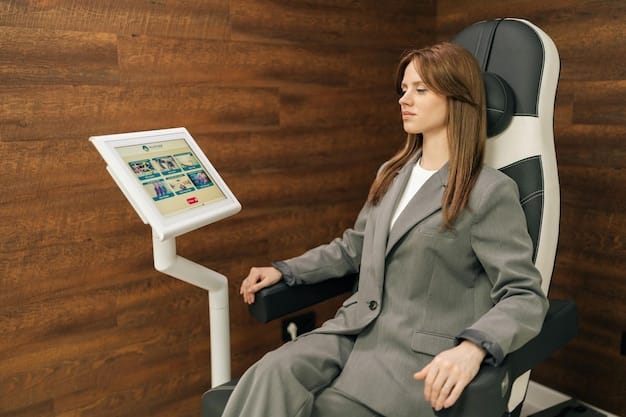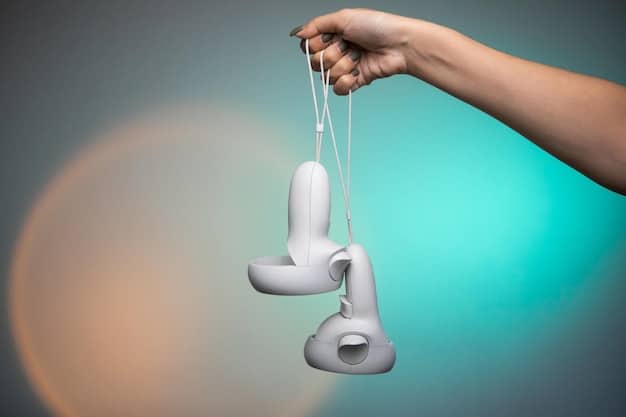Biofeedback for Anxiety: Can Training Reduce Symptoms by 30%?

Biofeedback training is a technique that helps individuals gain awareness and control over their physiological functions, potentially reducing anxiety symptoms by 30% through consistent practice and personalized guidance.
Are you struggling with anxiety and seeking a non-pharmaceutical approach to manage your symptoms? Can biofeedback training reduce anxiety by 30%? A science-based guide for US adults explore the potential of biofeedback, providing insights into how this technique could help you regain control over your body’s response to stress.
Understanding Biofeedback and Anxiety
Biofeedback is a mind-body technique that involves using electronic monitoring devices to become aware of physiological functions and learn how to control them. This awareness can be especially beneficial in managing anxiety.
Anxiety, a common condition affecting millions of adults in the US, can trigger various physiological responses, such as increased heart rate, muscle tension, and changes in brainwave activity. Biofeedback aims to help individuals gain conscious control over these responses, potentially leading to a reduction in anxiety symptoms.

What is Biofeedback?
Biofeedback training employs sensors attached to your body to monitor various physiological signals. These signals are translated into visual or auditory feedback, allowing you to observe your body’s responses in real-time.
How Does it Work for Anxiety?
By observing your physiological responses to stressors, you can learn to consciously control them through relaxation techniques and other strategies. This heightened awareness empowers you to manage your anxiety more effectively.
- Heart Rate Variability (HRV) Biofeedback: Focuses on increasing the variation in time between heartbeats, promoting relaxation and reducing stress.
- Electromyography (EMG) Biofeedback: Measures muscle tension, helping you learn to relax specific muscle groups that contribute to anxiety.
- Neurofeedback (EEG Biofeedback): Monitors brainwave activity, training you to shift brainwave patterns associated with relaxation and focus.
Ultimately, biofeedback offers a personalized approach to anxiety management, empowering individuals to take an active role in regulating their physiological responses to stress. This, in turn, may lead to a significant reduction in anxiety symptoms, potentially reaching the 30% reduction suggested.
The Science Behind Biofeedback and Anxiety Reduction
The effectiveness of biofeedback in reducing anxiety lies in its ability to bridge the gap between the conscious mind and the autonomic nervous system. Let’s explore the scientific basis for this claim.
Research indicates that biofeedback can produce measurable changes in physiological parameters associated with anxiety, such as heart rate variability, muscle tension, and brainwave activity. These changes, in turn, can lead to subjective improvements in anxiety symptoms.
Key Physiological Measures in Biofeedback
Biofeedback targets specific physiological markers that are known to be affected by anxiety. By monitoring and influencing these markers, individuals can learn to regulate their body’s stress response.
- Reduced Muscle Tension: EMG biofeedback can help individuals consciously relax tense muscles, alleviating physical symptoms of anxiety.
- Improved Heart Rate Variability: HRV biofeedback promotes a healthier balance in the autonomic nervous system, reducing the fight-or-flight response.
- Optimized Brainwave Patterns: Neurofeedback can train individuals to increase brainwave activity associated with relaxation and focus, decreasing anxiety-related brainwave patterns.
The scientific evidence supporting the use of biofeedback for anxiety is continually growing, with studies demonstrating its efficacy in a variety of anxiety disorders. However, it’s important to recognize that the results may vary among individuals depending on factors such as the severity of anxiety, individual motivation, and the specific type of biofeedback used.
Types of Biofeedback Techniques for Anxiety
Various biofeedback techniques can effectively address anxiety. Understanding the different types can help you choose the most suitable approach for your individual needs.
While each technique targets different physiological responses, they all share the common goal of increasing self-awareness and promoting voluntary control over bodily functions.

Common Biofeedback Methods
Each biofeedback method uses different sensors and techniques to monitor and provide feedback on specific physiological processes relevant to anxiety.
Some of the common methods are:
- Respiratory Biofeedback: respiratory biofeedback can help reduce anxiety and promote relaxation.
- Skin Conductance Biofeedback: Skin conductance biofeedback can help the body to lower sweat and reduce panic attacks.
- Temperature Biofeedback: Temperature biofeedback can help reduce anxiety and increase blood flow.
Selecting the right biofeedback technique depends on your specific anxiety symptoms and the physiological responses you want to target. Consulting with a qualified biofeedback therapist can help you determine the most appropriate approach for your individual needs.
What to Expect During a Biofeedback Session
Knowing what to expect during a biofeedback session can ease anxiety about the process. Let’s walk through a typical session.
The initial session usually involves an assessment of your anxiety symptoms and a discussion of your goals. The therapist will then explain the biofeedback process and how it relates to your specific needs.
The typical biofeedback session
Biofeedback session includes:
- Attachment of Sensors
- Real-time Feedback
- Techniques
Consistency is key to seeing results from biofeedback training. Many people find that regular sessions over several weeks or months lead to significant improvements in their anxiety symptoms.
Who Can Benefit from Biofeedback Training?
Biofeedback training offers a non-invasive way to manage anxiety, but who can truly benefit from it? It’s not just for those with severe anxiety disorders.
Biofeedback has shown promise for a range of conditions, particularly those linked to stress and anxiety. This makes it a versatile option for individuals looking for alternative or complementary therapies.
Ideal Candidates for Biofeedback
Biofeedback isn’t a one-size-fits-all solution. Certain individuals and conditions are more likely to respond positively to this type of training.
- Anxiety Disorders: Generalized Anxiety Disorder, Panic Disorder, Social Anxiety Disorder
- Stress-Related Conditions: Chronic Pain, Tension Headaches, Irritable Bowel Syndrome
- Performance Anxiety: Public Speaking, Sports Competitions, Musical Performances
Ultimately, biofeedback can be a valuable tool for anyone seeking to gain greater control over their physiological responses and improve their overall well-being. However, if you’re managing serious conditions, make sure always to consult a healthcare professional.
Finding a Qualified Biofeedback Therapist in the US
Finding a qualified biofeedback therapist is crucial for a safe and effective experience. Here’s how to locate a reputable practitioner in the US.
While biofeedback is generally considered safe, working with a qualified therapist is essential to ensure proper technique and personalized guidance. Look for therapists who are certified by reputable organizations.
Steps to Finding the Right Therapist
Finding a qualified biofeedback therapist could feel like a hard task. Here are some important steps to finding the right therapist.
- Certification
- Experience
- Approach
Remember, finding the right therapist is a collaborative process. Don’t hesitate to ask questions, express your concerns, and seek referrals to ensure you’re working with a practitioner who meets your needs and expectations.
Combining Biofeedback with Other Anxiety Treatments
Biofeedback can be a valuable addition to existing anxiety treatments. Let’s explore how it can be integrated with other therapeutic approaches.
While biofeedback can be effective on its own, it’s often used in conjunction with other therapies to enhance overall treatment outcomes. It can complement traditional approaches by providing individuals with a greater sense of self-awareness and control.
Integrating Biofeedback with Existing Approaches
Biofeedback could be used alongside with existing approaches.
- Cognitive Behavioral Therapy (CBT): CBT helps individuals identify and change negative thought patterns and behaviors that contribute to anxiety. Combining it with biofeedback can enhance self-awareness.
- Medication: Biofeedback can be used alongside medication to manage anxiety symptoms. It may potentially allow individuals to reduce their reliance on medication over time, under the guidance of their healthcare provider.
- Lifestyle Modifications: Regular exercise, a balanced diet, and sufficient sleep can all contribute to reduced anxiety levels. When combined with biofeedback, these lifestyle modifications can have a synergistic effect.
By carefully integrating biofeedback with other treatment modalities, individuals can create a comprehensive and personalized approach to anxiety management. Consulting with a qualified healthcare professional is essential to determine the best course of treatment for your specific needs.
| Key Point | Brief Description |
|---|---|
| 💪 What is Biofeedback? | A technique using sensors to monitor and provide feedback on body functions. |
| 🧠 How It Works | Helps you control physiological responses like heart rate to reduce anxiety. |
| 📊 Techniques | Includes HRV, EMG, and Neurofeedback. |
| 🌱 Benefits | Offers personalized anxiety management. |
Frequently Asked Questions
▼
Studies indicate that biofeedback is effective for many, reducing anxiety symptoms significantly. Success depends on individual factors, commitment, and the technique used, with many experiencing noticeable improvements.
▼
Some individuals may experience improvements within a few sessions, while others may require several weeks of consistent training. It depends on factors such as symptom severity and individual response.
▼
Yes, biofeedback is generally considered safe when performed by a qualified therapist. It’s a non-invasive technique with minimal risks, making it a safe alternative or complement to traditional treatments.
▼
The cost of biofeedback training can vary depending on the therapist’s rates, location, and the number of sessions required. Contact several therapists in your area to inquire about their fees.
▼
Some insurance plans may cover biofeedback training, particularly if it’s deemed medically necessary for treating a specific condition. Contact your insurance provider to inquire about your coverage options.
Conclusion
Biofeedback training offers a promising, science-backed approach to managing anxiety for US adults. While individual results may vary, the potential to reduce anxiety symptoms by 30%, coupled with its non-invasive nature, makes it a worthwhile consideration for those seeking alternative or complementary treatments. By understanding the science, exploring the different techniques, and finding a qualified therapist, you can take proactive steps towards regaining control over your body’s response to stress and improving your overall well-being.





